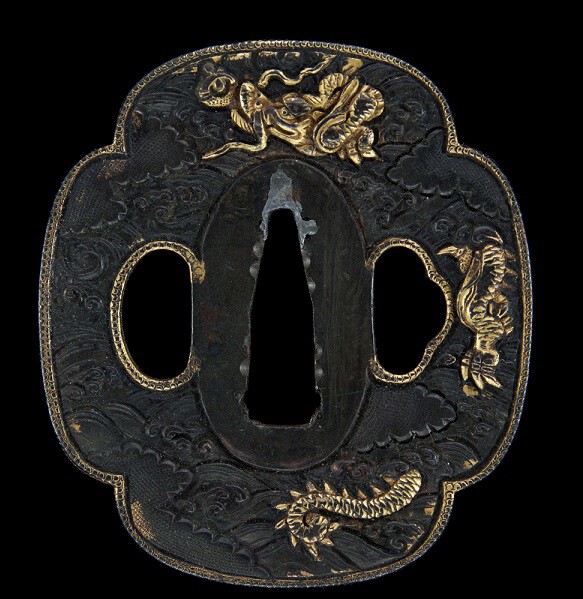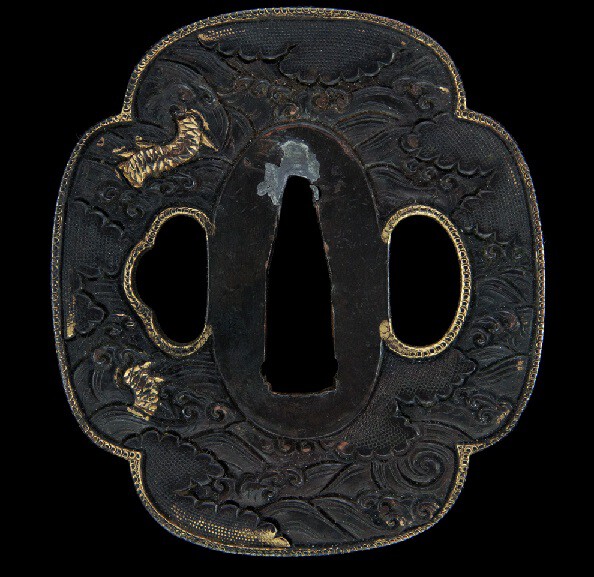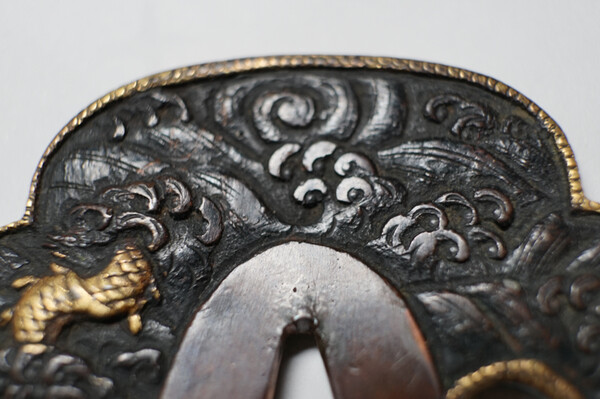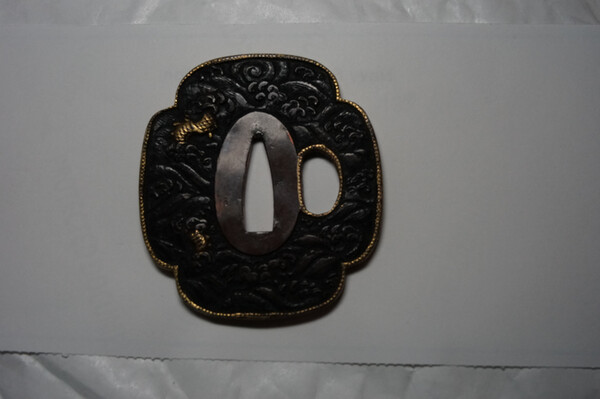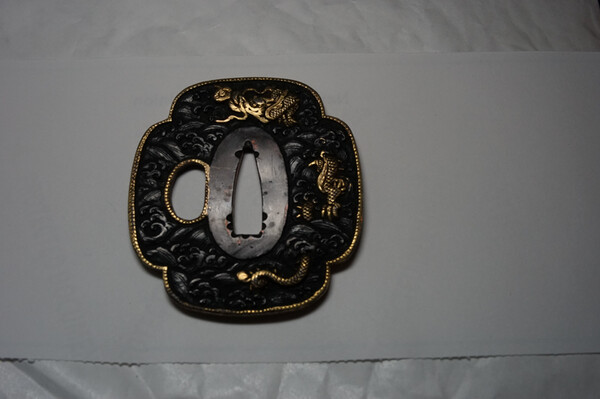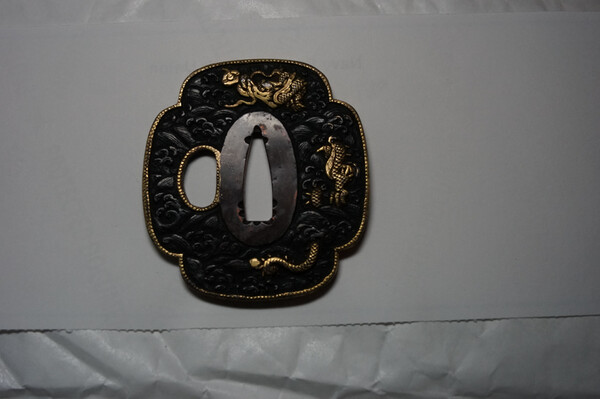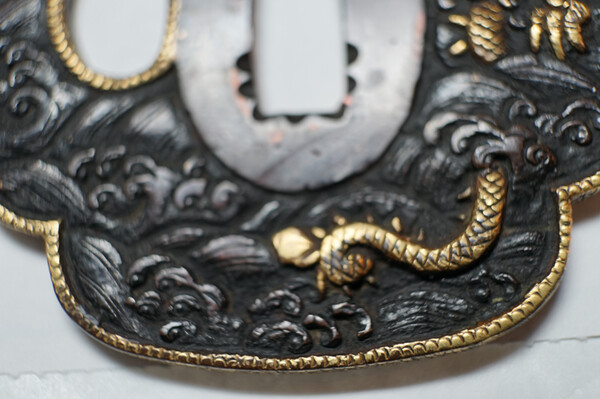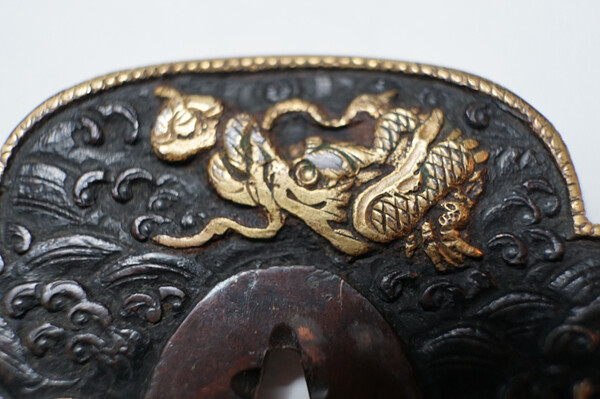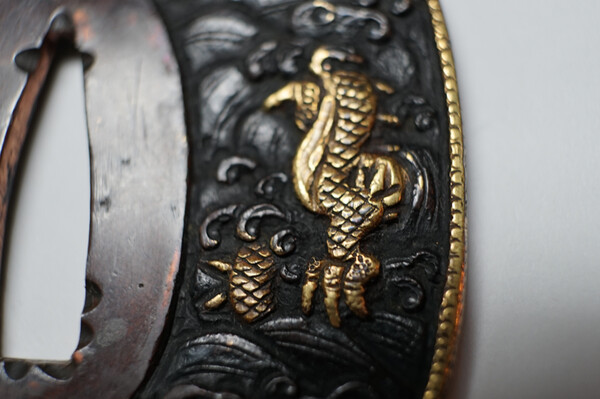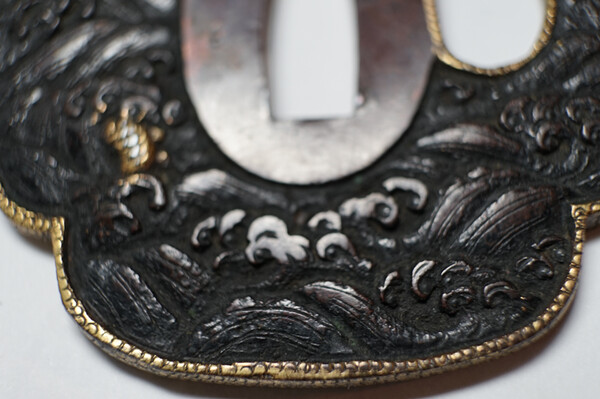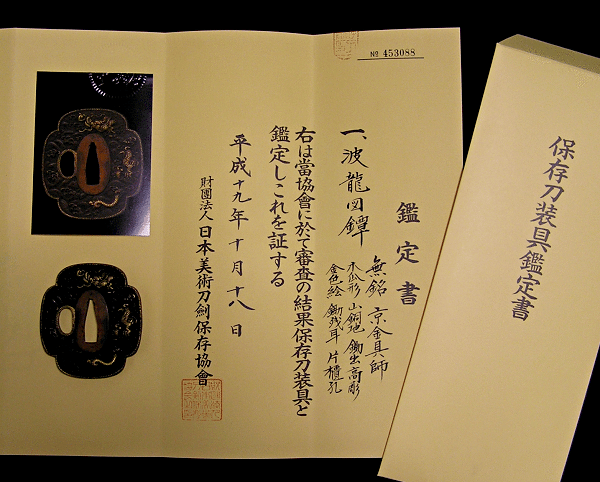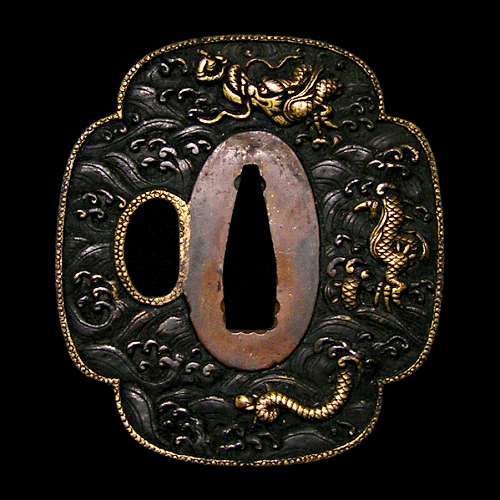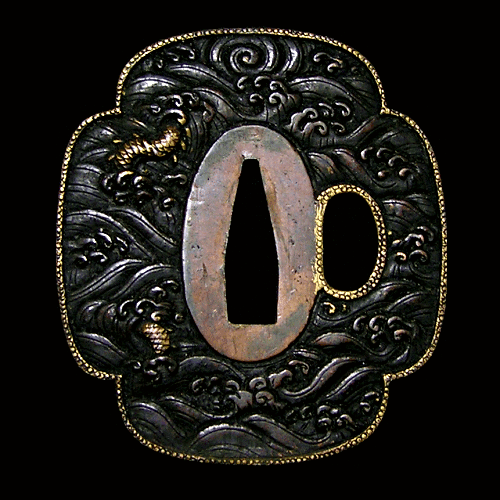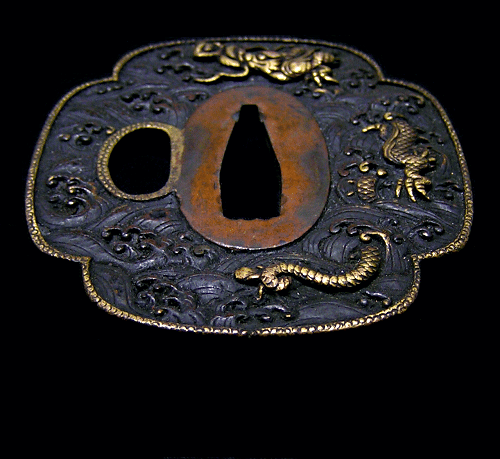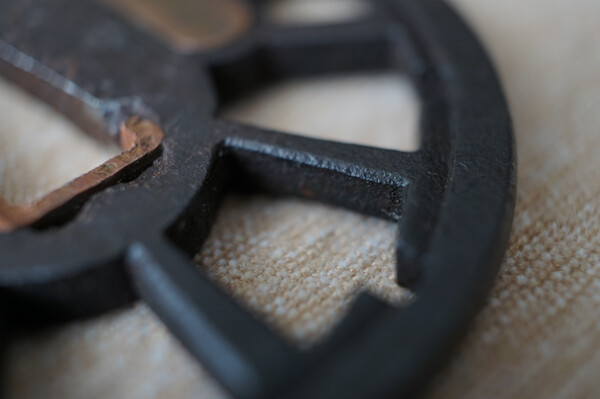-
Posts
732 -
Joined
-
Last visited
-
Days Won
1
Content Type
Profiles
Forums
Events
Store
Downloads
Gallery
Everything posted by kaigunair
-
Ebay or NMB, modern or old, the original point of my post/rant is being missed. I'm trying to wrap my head around why this design itself is so poor. Forget that it was an ebay listing for a moment as it is a distracting bias. I did not buy this thinking it was some $10k tsuba which I could flip, and it may still make for a nice iado set up if I ever get into that discipline (I just wouldn't want to use the tsuka it was intended to match). Roman, I appreciate your clarification points. But are you saying that you think there is a possibility that this might have been made from an older tsuba? It's comments like those that color the rest of the opinion given. Also, some, not all, of the points you brought up indicate you may be applying machibori techniques and standards to tetsu tsuba. Example: Looking at the sasano katsushi example david posted, close study indicates it isn't as symmetrical as it appears. Lacquering is another questionable comment, but at least I can probably test that one out...anyone know what chemical removes urushi without messing with patina (turpentine?). Anyhow, I readily admit this tsuba is no great work of art and modern made. Right now, all its bad qualities appear much more nuanced in my eye, which troubles me to no end if its as bad as people say it is. I'm trying to internalize what makes it so apparent for the next time something come up for sale on the NMB, ebay, pawn shop, Token Kai, etc... Everyone is entitled to their opinion, but this is me trying to sort it all out.
-
Wow, is it really that bad? Based on Pete's review, I'm readily able to accept that it is a post edo, "modern" tsuba. That the patina is modern. That the design isn't very tight. And sure, the plug isn't that great at all. But now, maybe its been lacquered? Or is an older tsuba that's been re-carved? And the design is totally amateurish and glaringly apparent. ok: begin rant: I did show this tsuba to a few members of the local club, tsuba collectors, for some in-hand opinions. None mentioned lacquering. None stated that design/carving was really bad. The comments I received from them about the inside of the rim was that there was some age based on the level of rust. I had to mentioned to them that I was considering it modern because of the patina and lack of more aging inside the sukashi. And I pointed out some areas that indicated that the design wasn't that well done. Based on some of the comments here, I was surprised that no one immediately said "modern" and "poor workmanship". As for the carving itself, yes, I agree that in-between the "spokes", those square shape cutouts aren't very tight, and in macro shots, the spokes themselves aren't perfect. But whoever did this took the time to angle each of the horizontal tops of the "T" so that the tops slope at an angle to the rim. The smith also filed each of the vertical edges of the long stroke in the "T", so there are actually 8 sides to each spoke. I've seen much simpler sukashi work, where it is just "cut out". In fact, some of the examples post of other wheel examples are good examples of this. I am really wondering what I'm missing that screams this is cr*p workmanship. To be honest, with the exception of the ko-shoami example David posted, this example seems more detailed than all the others. Not that the details themselves were done very well, but at least they were put in there. I actually prefer this style of rendition of a wheel and spokes to all the other examples posted (except the ko-shoami) - I just wish it was Edo period or older. So I am bothered that I am missing something in the execution of this design which should indicate "really bad" work. It could be that the club members I approached are being way too kind. Or the opposite is occurring here on the boards. -end rant- I do appreciate all the comments and eyes, but its a bit frustrating to not get consistent responses.
-
Conversely, it could be why there is a preponderance of certain types and motifs of ko-tosho and ko-katchushi examples that define the early tsuba, while a scarcity of other styles. When these "outliers" pop up, perhaps they get tossed into later periods, or maybe ko-kinko or ezo or ???. Really makes me wonder what other styles might have been in vogue at even earlier times and provinces, but perhaps not saved because they did not conform to the tea aesthetics....? At the same time, the entire opening of Tosogu no Kigen is about when tsuba first began, so will have to come back to this later...
-
Thanks all for the book suggestions. Early Japanese Sword Guards - good primer material indeed. interesting to hear about iron habaki, and their thinness too. I do wonder about the "conservation of material" in ko-tosho resulting in thinness in light of many examples of ko-kinko tsuba also being thin. The books states the iron was thin (in both the iron habaki and iron tsuba) because material was the same as used in nihonto, which is also reflected in the proportionally smaller negative silhouette sukashi work. I would think early kinko made in similar thinness/proportions might indicate a style, if not a particular purpose. Looks like pictures and study material of iron habaki is needed! Also interesting to note that ko-tosho is being attributed to sword smiths making the tsuba and habaki, based on the iron being of the same quality as nihonto. It further goes onto say that because the ko-tosh aren't signed, this indicates there were made by lower ranking smiths not entitled to sign their works. But when discussing the elegance and high standard of beauty, I can't see how this would then correspond to lower ranking smiths... Going through Tosogu no Kigen. Been sometime since I cracked the Sesko reprints of this one open, but it does appear packed with the background and info that's helpful to understanding early tsuba. Not sure what it'll say about thinness, but is making for a very nice read.
-
Is the person trying to buy them from you? Looks genuine to me. Quality is a different matter.
-
Thanks Boris, John, and Thierry. Theirry, that's a really great table. Was that one you compiled? Thanks John and Boris for explaining the subject in detail. Thickness and age does seem more complicated now. Most of the reference books/multi-volumes go something like aoi-shaped dolmounds tsuba --> tachi kanagushi--> ko-tosho /ko-katsushi/kagamishi, then split with a onin --> heianjo -->Yoshiro or early sukashi-->nobuie/kaneiye etc. Are there any books that focus on pre-edo tsuba & fittings (excluding ko-mino/ko-goto)? I have a small book on kagamishi tsuba by sasano; some of the examples there, if I recall correctly, don't seem to be kagamishi. Uchigatana no koshirae provides some good pictures of early tsuba in situ. Are there more books like that one? Lots to think about.
-
Thanks for the comments David. But I'm getting the feeling that there is no research or consensus out there regarding the thinness of early, non-tachi guards? I find it interesting that there are articles on dating tsuba by hitsu-ana shape, timeline of brass work in iron tsuba from onin-heianjo-yoshiro, and dating by sukashi characteristics, but no studies on thickness? Is this another landmine topic? If so, please PM me any past threads on it. Any good references to books or papers on the subject, English or Japanese would be much appreciated. Thanks in advance.
-
Interesting points. Would be nice if the weight of a tsuba was a common measurement along with thickness and length/width. Would be much easier to see how a large tosho compares to a thick but fairly open sukashi tsuba in terms of weight. I was wondering whether there had been any studies or research put out in the past. In passing, I've noticed that western cavalry sabers sometimes had large hilts compared to fencing sabers, and wondering if something like this was the cause for larger and thinner tsuba. Maybe a combination of horseback and smaller blades. Been thinking about this as I've been looking into the progression from onin to heianjo tsuba. Seems like the onin base plate is very much in the tosho flavor, while heianjo base plates were thicker with less plate work. Any leads to previous articles or publications would be much appreciated.
-
Was wondering what the prevailing theory is about why tosho, katsushi, and early ko-kinko tsuba's were relatively thin (about 2mm thick)? I know there are always exceptions to the rule, but like the nihonto shape charts that attribute changes in the sori and kissaki to adaptations caused by changing battle field environments, what happened with tsuba that made being a large (80mm+) and thin (2-3mm) plate useful in one era, and then thicker (4-6mm) and medium sized (70-80mm) plates the norm going forward? Horseback to foot soldier? Elegant sori's and shapes of earlier swords compared to later beefier blades? Tachi to uchigatana to katana? Larger tsuba good for protecting one's hand while on a horse, but harder for a quick draw? Maybe it gets in the way of a melee and could warp/crack compared to thicker tsubas against pole arms? Or perhaps thinner tsubas make sukashi work harder...thicker = thinner sukashi designs. Maybe keep the tanto & wak tsuba out of the equation for now....
-
FYI, Haynes auction catalog #6, lot 57: TYPICAL MITO SHOAMI WORK DECORATED WTH A TENATA. The rather well formed a hammered plate has the tenata (cutting knife) in high relief, and has a shakudo blade with silver yakiba and gold handle. A pair of menuki identical in style and design to this tenata were offered in Haynes catalogue #1, lot #278 they would go very well with this tsuba. Ca. 1775 Ht 8.3 cm, th 3.5mm(I-312) Seems like there are 3 identical examples of this style documented out there...
-
Hi Mauro, Thanks for the hi res pics. Still not sure about the rim and the weathering of the surface makes it really hard to tell if the details were cast or carved, at least to me. Been a very busy weekend, but a nice one for tsuba studies as the club set up at a local sakura matsuri. Hence the delayed response. I'm not sure we'll get any additional forward momentum on this without the help of more experienced eyes. But thank you so much for adding a lot to the thread and lots of good questions to ponder about construction and papering. Grazie mille!
-
They do paper old soft metal tsuba which are obviously cast. Any bronze tsuba (and there are a few made of this alloy among irogane ko tsuba) is cast. The operative word in the original statement being "copy". It surprises me that the difference in construction/quality of detail among the different examples Mauro has provided is being overlooked. Not that I am saying the nicer examples are any great works of art. But it is with a tinge of irony that the discussion then moves into a statement regarding the "boxes" or generalized categories that seem to gloss over important details of construction that the large papering organizations are guilty of. Rocks and glass houses? “The difference between the right word and the almost right word is the difference between lightning and a lightning bug ..." -Twain
-
Hi David, Thank you for the menuki examples. They seem to raise a different question regarding what constitutes kyo-kanagushi vs kyo-kinko, and whether one is really a higher designation than the other. The menuki comparison seems to indicate that in addition to any quality indicator, there may be some stylistic or construction kantei points to differentiate the two. Interesting indeed. I'm thinking Mauro's examples might be evidence of two different schools that made these types of tsuba - one that is "paperable" and another that made cast copies of this school. Perhaps the original designs were, at some level, popular (even as a tourist item) and gave rise to knocks offs. Using a standardized base plate and rim design might have made them easy to copy. Perhaps similar to the "collectible" hula dancer dash board souvenirs vs the really cheap dime store copies. Both are/were mass produced, but one is collectible and the other, well, isn't.
-
More thoughts: Thanks for the additional examples Mauro. From the additional pictures of the "flower" and the "building" theme, one might make an observation that A appears to be a possible copy (maybe cast + finishing) of B. Similarly, D is a cast copy of C. There is a funny outline on A, and the details don't seem a crisp. Mauro: how well defined is the edge work on your example? It seems to lack any depth/definition of the punch marks compared to the others, but that might just be the photo.... I think I missed your earlier post where you posit it might that the tsubas are both kyo-kanagushi and shiiremono. It does make me wonder whether the NBTHK does or does not paper "shiiremono" since it is a term that can have different definitions. But I'm pretty sure they wouldn't want to paper a cast copy type tsuba. If all these tsubas were made from casts that were later "refined", then I feel the NBTHK papering would have been done in error. If these were merely a style of tsuba and properly labeled kyo-kanagushi, then the NBTHK papers are ok. Now if some are cast and some are not, that too would be an interesting development. I can see a production/workshop/"atelier" set up where a standard base plate was made and possibly the "nanako" (very loosely used) edge work was added. Then the plate was given to someone to carve out the background as well as the dragon. It might be that the dragons/flowers/pagoda are made separately and inlayed onto the base tsuba vs carved from the ground, before being sent to a person to do the ground work (but doesn't seem like it in my example). This would explain the consistency of the backgrounds, as well as the examples with a completely different background. For a higher quality example, it would also be similar to the use of subcontractors by the goto for the ground work (yoshioka, yasuda, nomura). If the only thing "cast" in this example was the base tsuba shape, which for kinko is nothing significant, then the papers would be ok. But if the other elements like the edge work are part of the cast, or if the dragon/flower/pagoda are stamped/pressed/cast pieces and inlayed into the base tsuba, then I would feel the papers were given in error. We would also want to make sure we're not dealing with two different "workshops" here: one workshop that made low quality (but carved) kyo-kanagushi, and another that made even lower quality cast copies of these for export (i.e. the real shiiremono). So while these are far from any goto works, it does seem like they might have some value to add about our understanding of late period tosogu production, as well as papering criteria.
-
moustashes...or whiskers. With dragons, it's all in the tail. I think it's more important to nail down the construction techniques in order to support or disprove the NBTHK certification. You had mentioned these were cast, which would be a good indicator of shiiremono vs kyo kanagushi. does the new dragon example, with a completely different background support this? Would also be good to get close ups of your example; it is relatively unfinished compared to all the others, so we would want to rule out yours being a cast copy of one of the others.
-
here's another example, dragon looks identical (well, this one is a female), but with a completely different background! Mauro, does this fit into your construction theory? Or is this just a style/motif that was done profusely by this group?
-
:D shiiremono? Even though the NBTHK paper clearly states kyo kanagushi? Multiple near identical copies alone would not mean low quality mass production item. And example A is in pretty poor condition. I can provide macro shots of any area of my example for side by side comparison shots to rule out kyo kanagushi and confirm shiiremono/hamamono as well as construction techniques. My, what an interesting thread this just became...
-
And thought, "boy, that looks alot like the tsuba that came with a koshirae I picked up a while ago..." Pics of my tsuba:
-
:D Came across this listing with NBTHK papers to Kyo-kanagushi: http://tsuba.jyuluck-do.com/TU10481.html Some pics from the listing:
-
Thanks everyone for the input. Still a Good Friday, not so much a good Tsuba. These tetsu's are trickey ones indeed. Pete, thanks for the second look. Modern it is in my book now. But a good lesson learned. David, appreciate the detailed explanation and insight into Buddhism. Does lend more support to the conclusion it is a wheel based designed. Some of the other Tsubas I had been picking up had connections to Buddhism, so it would have been complimentary if this one was also of the type. But makes sense that it is only a wheel. Piers, I think the link is the clincher that it is in all likelihood a 12 spoke wagon wheel. And definitely see possible symbolism in the number of spokes (if seen as nails) and the number 12. Makes me a little more disappointed it appear that this is a modern made Tsuba. My tsuka is now still in need for an appropriate edo period mate.
-
Good points pete. Thanks. I was thinking the same myself. I did see the middle of the sukashi areas had a line of rust, but I do not know how much or how little tetsu tsuba should have. I do think it might have been mounted until pretty recently based on wear on the nakago ana and inside of the kozuka ana. Will try to get better photos to show the line of oxidation. How recent is recent? Much appreciated. Pictures using macro plus extension (Ambient daylight plus direct sunlight shots):
-



